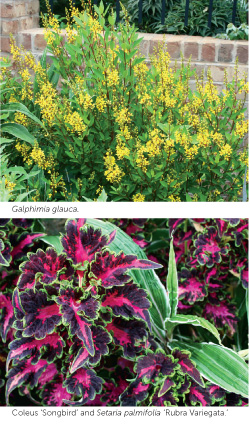| With the constant clamor for landscape color, coupled with a desire for tough, high-performing plants, it’s not surprising that tropical plants are in vogue. Whether you call them tender perennials or even annuals, these plants all have their roots, so to speak, in the tropics. If you think these plants aren’t tough just because they aren’t cold hardy, think again. No matter how hot the summers get, these hot-blooded green machines will daily deliver good-looking foliage (which is oftentimes highly colorful) and non-stop flowers until you or the first freeze of fall takes them out. Coleus Of course, if you want to talk about foliage in tropical plants, then you can’t ignore the plethora of beautiful coleus (Solenostemon scutellarioides) cultivars that continue to be developed. Everyone has their own personal favorites, but for me, I am excited by them more when they are grouped with other plants rather than when they are bedded out in masses. In this regard, Adrienne Roethling, garden curator at Paul J. Ciener Botanical Garden (PJCBG), has excelled in creating dramatic plantings. Here are a few hints as to how coleus can be used in non-traditional ways.
Copper plants Another group of tropical plants with great foliage is the copper plants (also called copper leaf), the many cultivars of Acalypha wilkesiana. Although copper plants are generally not small-statured, they are great for adding height and bold-textured foliage to the summer garden. Plus, they can take a hard pruning if they are outgrowing your site.  Classically, copper plants are best known by the cultivars with (drum roll, please) copper-tinted foliage. At PJCBG, we used a mass planting of tall, large-leaved ‘Haleakala’ and ‘Brazen,’ set off with the small-leaved and compact-statured ‘Inferno’ in front. If you don’t care for these bright colors, most of the leaf forms you see in copper (‘Obovata Cristata’) can also be found in green, too (‘Hoffmanii’). Just don’t plant your copper plants too early, as they strongly resent temperatures below 50°F, especially cool soil temperatures. Classically, copper plants are best known by the cultivars with (drum roll, please) copper-tinted foliage. At PJCBG, we used a mass planting of tall, large-leaved ‘Haleakala’ and ‘Brazen,’ set off with the small-leaved and compact-statured ‘Inferno’ in front. If you don’t care for these bright colors, most of the leaf forms you see in copper (‘Obovata Cristata’) can also be found in green, too (‘Hoffmanii’). Just don’t plant your copper plants too early, as they strongly resent temperatures below 50°F, especially cool soil temperatures.Flowers, too Now, just so you don’t think I’ve gone completely crazy ignoring flowers, I’ll mention a couple of exciting tropical shrubs. Red flag bush (M. erythrophylla, sometimes seen incorrectly listed as M. coccinea) is a fabulous continuous-blooming shrub with bicolored flowers. In M. erythrophylla, the corolla is white, while the enlarged sepal is fire-engine red. This plant can be discerned at a great distance, so showy are its blooms. Grow red flag bush in a bright sunny setting in well-drained soils. Poor soil drainage will result in foliar iron chlorosis. Golden thryallis (Galphimia glauca) is another flowering machine, this plant being popularly seen in southern Florida as a landscape subject. Although it is not as easily propagated as other tropicals, it is well worth acquiring (preferably in larger sizes due to its slower growth rate) and used because of its constant parade of bright yellow flowers. Golden thryallis does possess some minimal cold hardiness, with the evergreen leaves surviving the first frosts until temperatures drop below 27°F. Oldies but goodies I’ll highlight just three more examples that tell stories of where we’ve come with tropicals. The first two are in many ways old standbys of the Deep South, plants I knew from my childhood in southern Louisiana as “old-fashioned” has-beens—Duranta erecta (golden dewdrop or Brazilian skyflower) and Tradescantia pallida (purple heart or setcreasea). Duranta certainly has come a long way since the 1970s, with a plethora of gold-leaved, variegated and picotee-flowered cultivars now available. One plant that I ran across in Japan in 2005 was given to me as D. erecta ‘Aussie 2000’—a reverse variegation that I had not previously seen, with gold-centered/green-edged leaves borne on a highly compact frame. In the world of T. pallida, much new information has also been learned, as it is generally now accepted that this species is perfectly root-hardy in USDA Hardiness Zone 7. Thanks to this realization, it is now possible to use the many new beautiful cultivars of purple heart (not all of which have purple leaves) as herbaceous perennials in Zone 7 and warmer. One of my favorites is the relatively newly named T. pallida ‘Pale Puma,’ a plant I suspect may actually represent a hybrid between T. pallida and T. sillamontana (white velvet). And consider this final plant, Pentapetes phoenicea (commonly called “copper cups”), a true annual introduced by Thomas Jefferson to Monticello in 1811. This annual, somewhat related to cacao, is also being rediscovered for its upright form and alluring red-orange flowers. These tropicals will enliven the garden with color and tropical energy, while also celebrating the historic path we’ve taken in bringing (and sometimes rediscovering) these plants as worthy garden subjects. F. Todd Lasseigne is executive director, Paul J. Ciener Botanical Garden, Kernersville, N.C.; todd@pjcbg.org. |

Explore the June 2011 Issue
Check out more from this issue and find your next story to read.
Latest from Garden Center
- GS1 US Celebrates 50-Year Barcode 'Scanniversary' and Heralds Next-Generation Barcode to Support Modern Commerce
- Weekend Reading 7/26/24
- Retail Revival: Making gardening contagious
- ‘Part of our story’
- Registration now open for Garden Center Fertile Ground Webinar Series
- Dramm introduces new hose, sprinkler attachments for home gardeners, nurseries
- Meet the 15 Retailers' Choice Awards winners from Cultivate'24
- 2024 Top 100 Independent Garden Centers List





